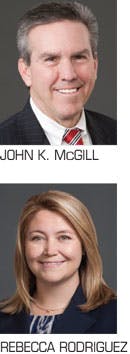By John K. McGill, JD, CPA, MBA, and Rebecca H. Rodriguez, CPA, CFP®
When doctors purchase an item for their business, it is either deducted as a current expense or capitalized as a fixed asset. Fixed assets are given applicable "useful lives," and the original cost basis is deducted over that period. Previously, there was no bright line rule for the dollar value at which items became fixed assets versus currently deductible. Typically, if the item had a useful life of more than 12 months, it was required to be capitalized. In some cases, practices would identify a minimum dollar value on which to base book capitalization decisions, but previously there was no corresponding threshold explicit in the tax code.
The new regulations now provide doctors with guidance in this area. Practices may now make a de minimis safe harbor election, which allows doctors to follow their book minimum capitalization policy for tax purposes. For practices without an audited financial statement, the minimum capitalization threshold generally cannot exceed $500 per item. If it's on the same invoice, the cost of an item must include delivery fees, installation, and similar costs. In order to rely on this safe harbor, doctors must have a written policy in place as of the beginning of the tax year.
RELATED | Increasing ROI by saving tax dollars
The law also provides guidance on repairs, outlining when repairs should be capitalized versus deducted. Repairs on an asset generally must be capitalized if the repairs improve the unit of property. An improvement would include a material addition, increase in capacity, productivity, efficiency, strength, quality, or output of a unit of property. In addition, an amount paid that returns a unit of property to working condition if it has deteriorated to a state of nonfunctional disrepair; the replacement of parts that comprise a major component or substantial structural part of the unit of property; or adapting a unit of property to a new or different use all need to be capitalized too.
The determination of whethCost segregation studies have been popular in the past due to their ability to break out costs from a 39-year depreciable life for buildings, to a more accelerated timeline. The regulations add two significant benefits for obtaining a study. The first is being able to identify each of the eight defined building systems for purposes of evaluating whether future amounts paid must be capitalized or expensed. The second is the ability to reflect a partial disposition and write-off the remaining basis in the property disposed, as opposed to continuing to depreciate it over a 39-year life. If doctors own the building in which they practice, or are in the process of building, it is good to discuss obtaining a cost segregation study.
RELATED | Why HSAs are the ultimate tax-saving device for dentists
Doctors need to make sure they abide to the changes on whether an item is currently deductible or whether it should be capitalized. As a result, when a situation arises, doctors should contact their CPA to ensure they comply with the new regulations.
John McGill, JD, CPA, MBA, provides tax and business planning, and Rebecca Rodriguez, CPA, CFP® provides accounting services exclusively for the dental profession. The McGill & Hill Group, LLC, is your one-stop resource for tax/business planning, practice transition, legal, retirement plan administration, CPA, and investment advisory services. Visit www.mcgillhillgroup.com.








